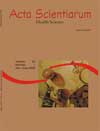<b>Comparative study between serological and PCR-SSP methods to determine class II HLA molecules</b> - DOI: 10.4025/actascihealthsci.v26i2.1585
Abstract
The direct detection of HLA polymorphism was an extremely difficult task until a short time ago, mainly for Class II alleles. It has become easier due to Polymerase Chain Reaction-Sequence Specific Primer (PCR-SSP) technique. Serological and PCR-SSP methods were compared when antigens HLA-DR and –DQ were typed in healthy donors with homozygous phenotype (blanks) and in patients who, for some reason, could not be typed by serological method. This comparative study showed that 21% of healthy donors showing blanks by serological method had their alleles defined by molecular method (PCR-SSP) and that 17% of renal patients with neither proper quantity nor quality of B lymphocytes to define their Class II HLA antigens were all defined by the PCR-SSP method. Molecular typing was adequate for patients with low B lymphocytes quantity and quality. Phenotypic homozygosis index for HLA-DR decreased, HLA-DQ1 splits alleles were better defined, and rare associations between DRB1 and DQB1 were established.Downloads
Download data is not yet available.
Published
2008-03-31
How to Cite
Borelli, S. D., Souza, D., Freitas, K. F. F., Botini, F. F., Melo, F. C. de, & Bedento, J. (2008). <b>Comparative study between serological and PCR-SSP methods to determine class II HLA molecules</b> - DOI: 10.4025/actascihealthsci.v26i2.1585. Acta Scientiarum. Health Sciences, 26(2), 337-340. https://doi.org/10.4025/actascihealthsci.v26i2.1585
Issue
Section
Clinical Analysis
DECLARATION OF ORIGINALITY AND COPYRIGHTS
I Declare that current article is original and has not been submitted for publication, in part or in whole, to any other national or international journal.
The copyrights belong exclusively to the authors. Published content is licensed under Creative Commons Attribution 4.0 (CC BY 4.0) guidelines, which allows sharing (copy and distribution of the material in any medium or format) and adaptation (remix, transform, and build upon the material) for any purpose, even commercially, under the terms of attribution.
Read this link for further information on how to use CC BY 4.0 properly.























5.png)







